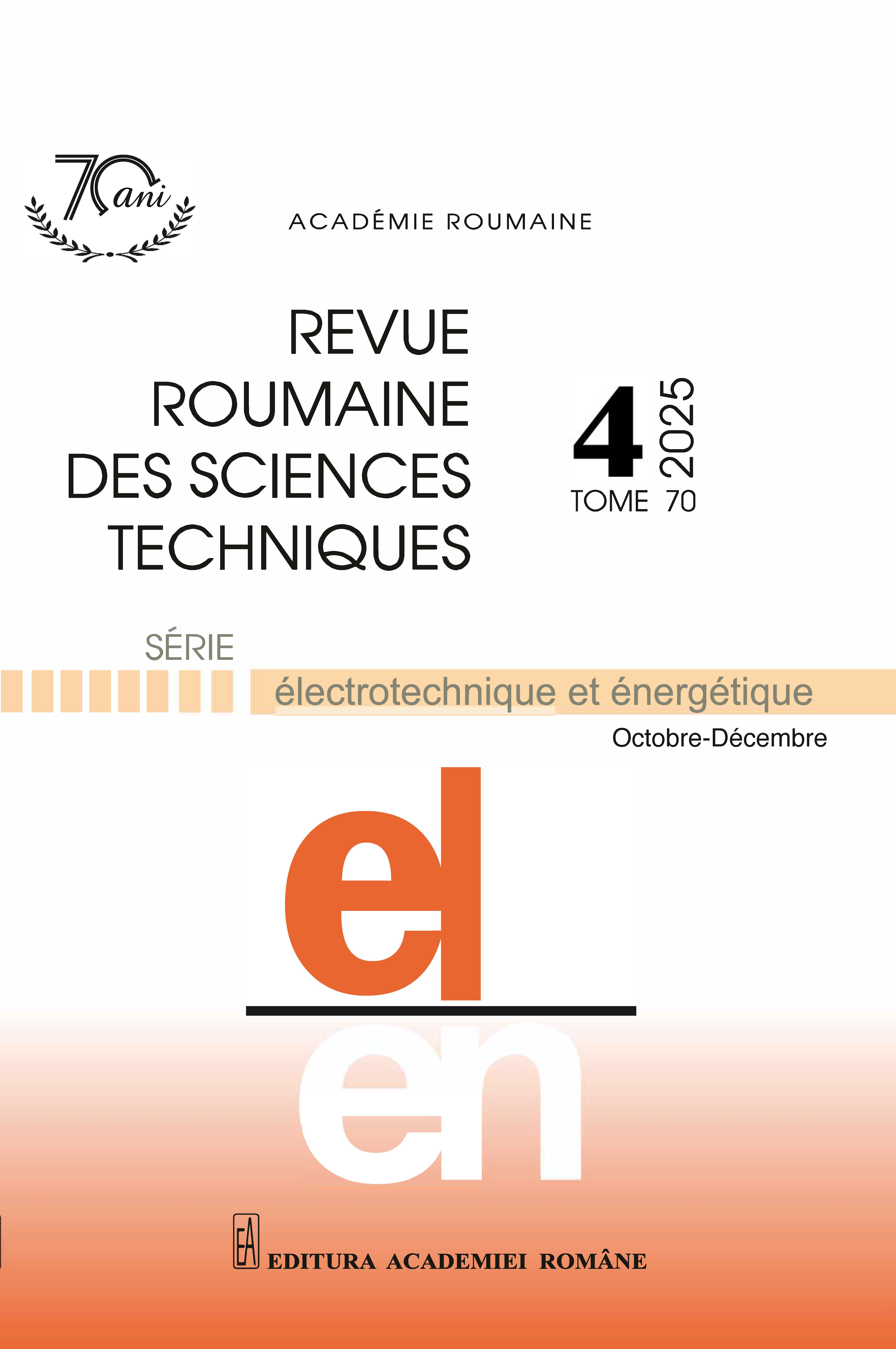DÉTECTION ET DIAGNOSTIC DES DÉFAILLANCES DANS LES SYSTÈMES D'ÉLECTRICITÉ PHOTOVOLTAÏQUE À L'AIDE DE L'APPROCHE DE MATRICE ALÉATOIRE DE FISHER
DOI :
https://doi.org/10.59277/RRST-EE.2025.4.14Mots-clés :
Détection et diagnostic des défauts (FDD), Systèmes photovoltaïques (PV), Théorie des matrices aléatoires de Fisher (RMT), Surveillance en temps réel, Analyse multidimensionnelle des donnéesRésumé
Cet article propose une nouvelle méthodologie pour la détection et le diagnostic des défauts (FDD) dans les systèmes photovoltaïques (PV) qui combine le discriminant linéaire de Fisher (FLD) avec la distance de Mahalanobis. L'approche utilise le FLD pour réduire la dimensionnalité des données opérationnelles tout en maximisant la séparation entre les états sains et défectueux. La distance de Mahalanobis est ensuite utilisée pour détecter les anomalies en tenant compte des corrélations entre les variables telles que la tension, le courant et la température. La validité de la méthode a été établie à l'aide de données réelles issues d'une centrale PV de 20 MWc en Algérie. Les résultats obtenus démontrent l'efficacité de la méthode proposée pour classer divers défauts, notamment les défauts de circuit ouvert, d'ombrage et de court-circuit. Cette approche présente des améliorations substantielles en termes de précision de détection, d'efficacité et de réduction des fausses alarmes par rapport aux méthodologies conventionnelles. La solution FDD proposée est robuste et évolutive, ce qui la rend idéale pour la surveillance en temps réel des systèmes photovoltaïques à grande échelle.
Références
(1) B. Gong et al., Fault diagnosis of photovoltaic array with multi-module fusion under hyperparameter optimization, Energy Conversion and Management, 319 (2024).
(2) B. Ponnuswamy, C. Columbus, S.R. Lakshmi, and J. Chithambaram, Wind turbine fault modeling and classification using cuckoo-optimized modular neural networks, Rev. Roum. Sci. Techn. – Électrotechn. et Énerg., 68, 4, pp. 369–374 (2023).
(3) C. Saiprakash et al., Improved fault detection and classification in PV arrays using Stockwell transform and data mining techniques, Results in Engineering, 23 (2024).
(4) K. Ding et al., Feature extraction and fault diagnosis of photovoltaic array based on current–voltage conversion, Applied Energy, 353 (2024).
(5) F. Harrou, A. Saidi, Y. Sun, and S. Khadraoui, Monitoring of Photovoltaic Systems Using Improved Kernel-Based Learning Schemes, IEEE Journal of Photovoltaics, 11, 3, pp. 806–818 (2021).
(6) E.Q.J. M. and V. Subramanian, Strategic load flow assessment for a ship microgrid with photovoltaic power integration, Rev. Roum. Sci. Techn. – Électrotechn. et Énerg., 70, 3, pp. 397–402 (2025).
(7) A. Saidi, B. Cherif, and B. Chellali, Fuzzy intelligent control for solar/wind hybrid renewable power system, EEA - Electrotehnica, Electronica, Automatica, 65, 4 (2017).
(8) R. Tang et al., Fault classification of photovoltaic module infrared images based on transfer learning and interpretable convolutional neural network, Solar Energy, 276 (2024).
(9) Z. Hu et al., Improved multistep ahead photovoltaic power prediction model based on LSTM and self-attention with weather forecast data, Applied Energy, 359 (2024).
(10) M. Jalal et al., Deep learning approaches for visual faults diagnosis of photovoltaic systems: State-of-the-Art review, Results in Engineering, 23 (2024).
(11) A. Keddouda et al., Photovoltaic module temperature prediction using various machine learning algorithms: Performance evaluation, Applied Energy, 363 (2024).
(12) D. Li et al., Sensing anomaly of photovoltaic systems with sequential conditional variational autoencoder, Applied Energy, 353 (2024).
(13) Q. Qi et al., Development assessment of regional rooftop photovoltaics based on remote sensing and deep learning, Applied Energy, 375 (2024).
(14) T. Peng et al., An integrated framework of Bi-directional long-short term memory (BiLSTM) based on sine cosine algorithm for hourly solar radiation forecasting, Energy, 221 (2021).
(15) J. Zhang et al., Fast object detection of anomaly photovoltaic (PV) cells using deep neural networks, Applied Energy, 372 (2024).
(16) H. Wang et al., Multi-prediction of electric load and photovoltaic solar power in grid-connected photovoltaic system using state transition method, Applied Energy, 353 (2024).
(17) E.A. Ramadan et al., An innovative transformer neural network for fault detection and classification for photovoltaic modules, Energy Conversion and Management, 314 (2024).
(18) M.F. Tahir et al., Enhancing PV power forecasting with deep learning and optimizing solar PV project performance with economic viability: A multi-case analysis of 10 MW Masdar project in UAE, Energy Conversion and Management, 311 (2024).
(19) A. Słowik et al., An efficient approach to parameter extraction of photovoltaic cell models using a new population-based algorithm, Applied Energy, 364 (2024).
(20) L.-A. Mustaţǎ, G.-D. Sorea, and E. Helerea, Monitoring and control software for a standalone house supply system, Rev. Roum. Sci. Techn. – Électrotechn. et Énerg., 70, 2, pp. 169–174 (2025).
(21) E.Q.J. M. and V. Subramanian, Strategic load flow assessment for a ship microgrid with photovoltaic power integration, Rev. Roum. Sci. Techn. – Électrotechn. et Énerg., 70, 3, pp. 397–402 (2025).
(22) L. Khettache, M.R. Rezoug, A. Saadi, and L. Sahraoui, A novel design of a photovoltaic system based on a linear induction motor and a reciprocating pump, Rev. Roum. Sci. Techn. – Électrotechn. et Énerg., 70, 1, pp. 3–8 (2025).
Téléchargements
Publiée
Numéro
Rubrique
Licence
(c) Copyright REVUE ROUMAINE DES SCIENCES TECHNIQUES — SÉRIE ÉLECTROTECHNIQUE ET ÉNERGÉTIQUE 2025

Ce travail est disponible sous licence Creative Commons Attribution - Pas d'Utilisation Commerciale - Pas de Modification 4.0 International.


